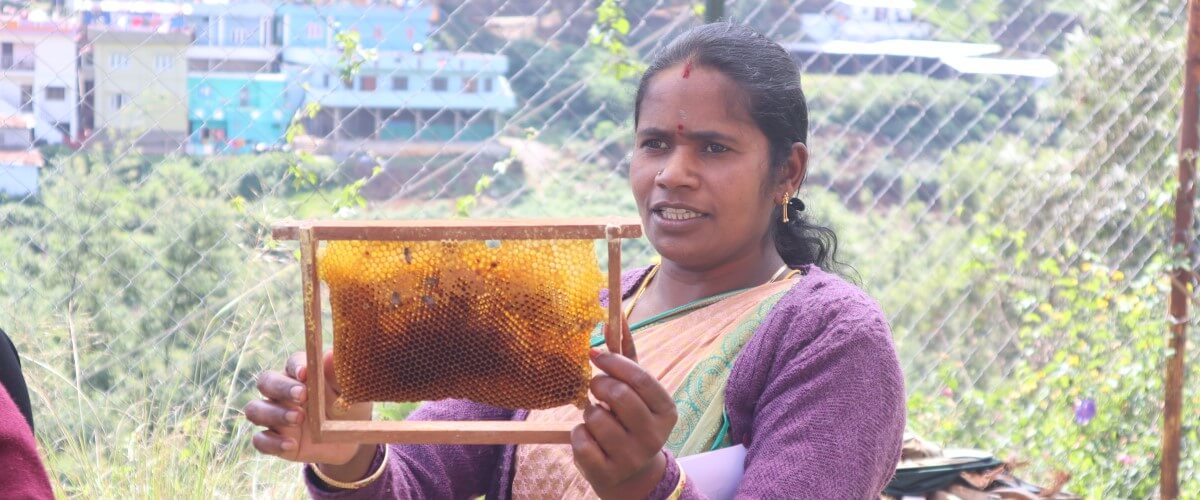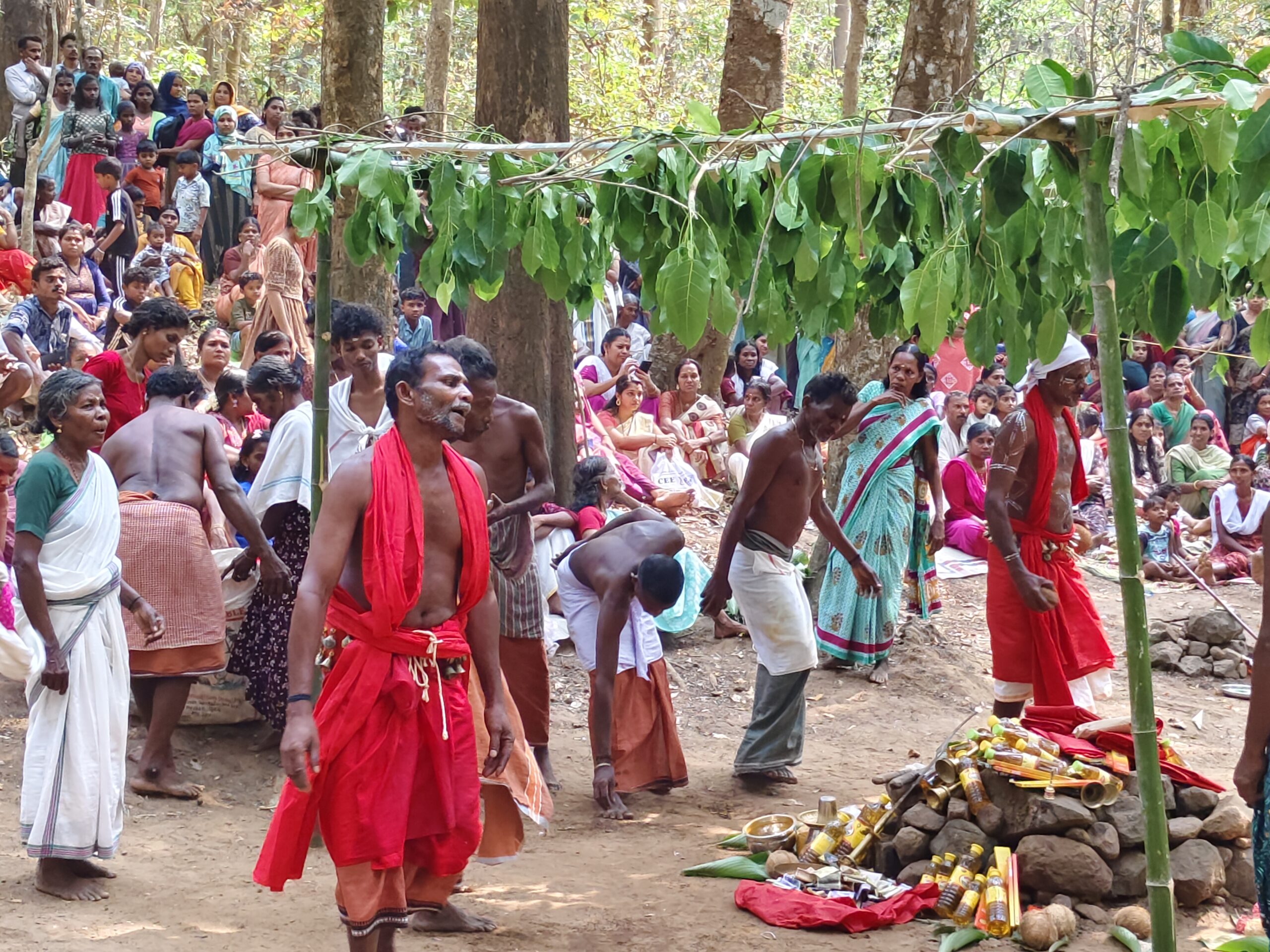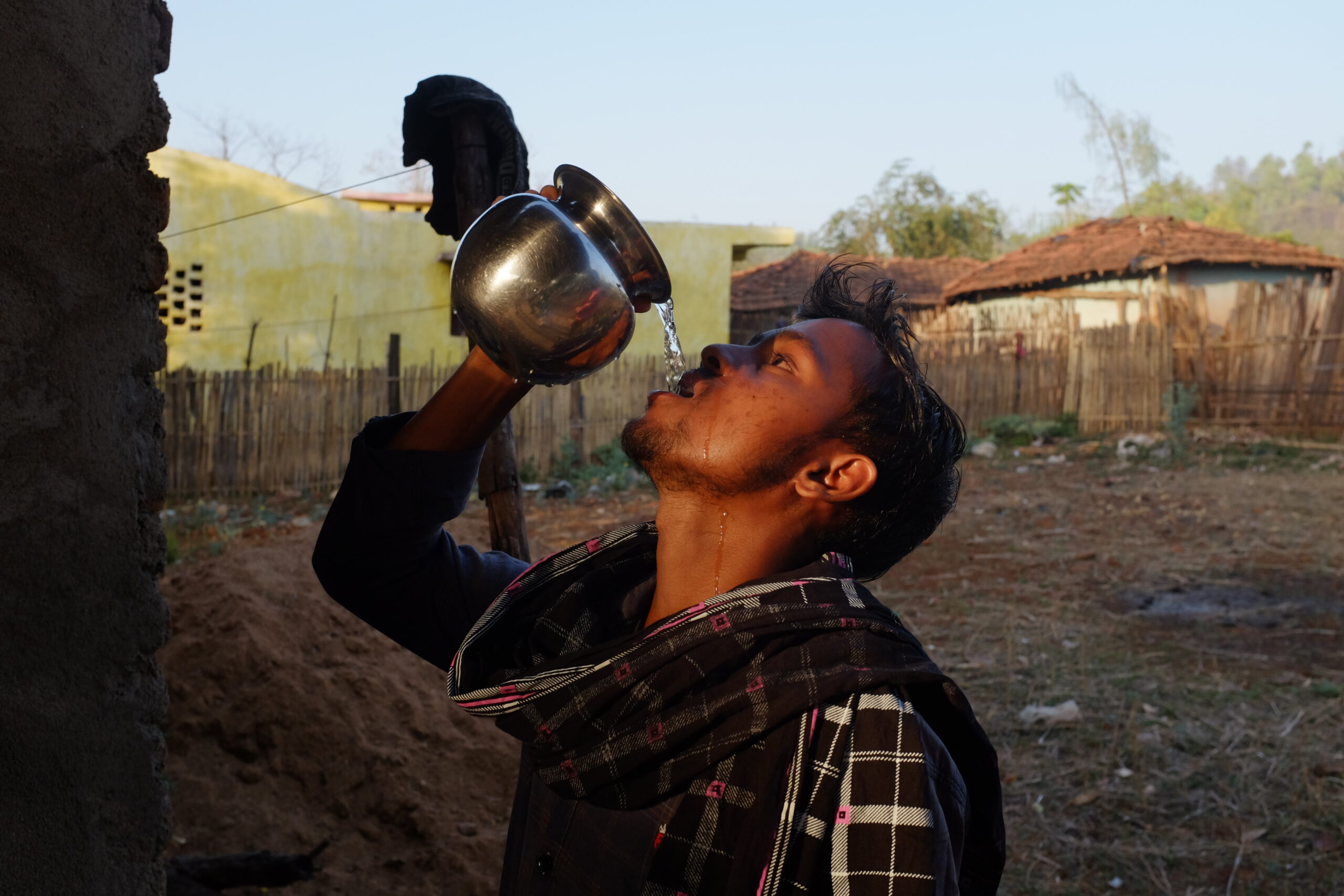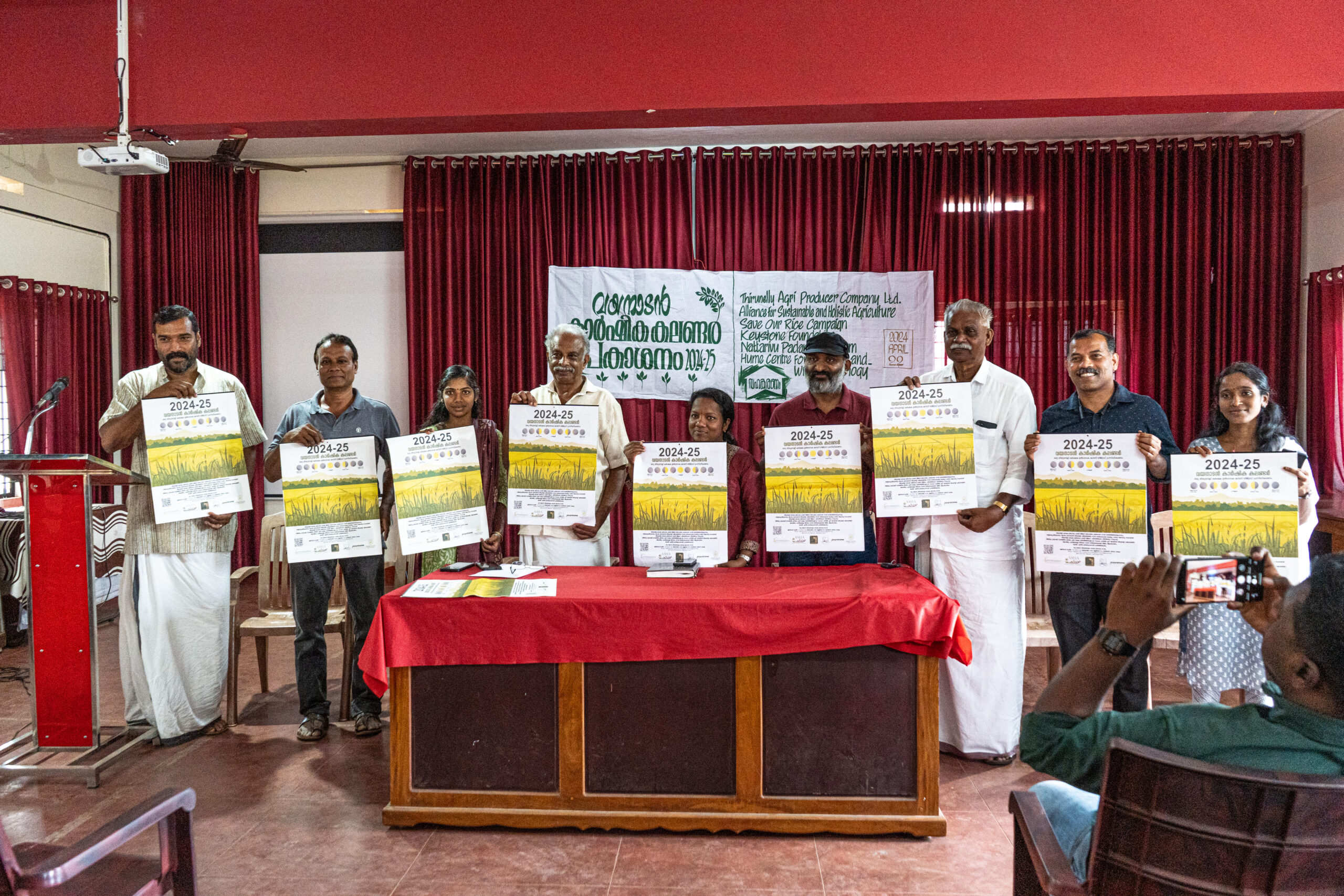May 9, 2023
By Manimegalai, Climate Educator, Climate Change programme)
என் பெயர் மணிமேகலை, இயற்கை சூழல் நிறைந்த நீலகிரி மாவட்டம் கோத்தகிரி வட்டம் அம்பேத்கர் நகரில் வசித்து வருகிறேன். பி.காம் முடித்துள்ளேன். எனது வேலையைத் தவிர, நான் தன்னார்வலராகப் பணியாற்றுவதில் ஆர்வமாக உள்ளேன், எனவே இப்போது கீஸ்டோன் அறக்கட்டளையின் காலநிலை-ஸ்மார்ட் வகுப்பின் மூலம் இயற்கையில் என்ன மாதிரியான மாற்றங்களைக் காண்கிறார்கள் என்பதைப் பற்றி குழந்தைகளுக்கு கற்பிக்கிறேன். இதன் மூலம் தேனீ வளர்ப்புமுறை பற்றி பயிற்சி கிடைத்தது. இந்த பயிற்சியை எடுப்பதற்கு முன், தேனீக்கள் பற்றி எதுவும் தெரியாமல் இருந்தேன், எங்கிருந்தாவது சாப்பிடுவதற்கு தேன் கிடைத்தால் போதும் என நினைத்தேன். ஆனால் தேனீ வளர்ப்பு பயிற்சிக்கு வந்தபோது தான் என்னை மிகவும் வியப்படைய செய்தது. தேனீ வளர்ப்பு பயிற்சியின் போது ராணித் தேனீயை பற்றிதெரிந்துக் கொண்டபோது நான் வியப்படைந்தேன் ராணி தேனீ தனது கூட்டத்தை எவ்வாறு கட்டுகோப்பாக வைத்துள்ளது என தெரிந்து கொண்டான் .ராணியை போலவே வேலைக்கார தேனீக்களும் எந்த அளவு தன்னுடைய வேலைகளை செய்கின்றது . இந்த தேனீக்கள் மூலம் ஒரு குடும்பத்தின் வாழ்க்கையை ஞாபகத்திற்கு கொண்டு வருகின்றது . பயிற்சியின் பொது தேனீக்களின் வேலைகளை பற்றி சொன்னார்கள் அப்பொழுது ராணியின் வேலை முட்டையிடுவது கூட்டத்தை கட்டுக்கோப்பாக வைப்பது மற்றும் ஆண் தேனீயின் வேலை இனம் சேர்வது மட்டுமே அதன் வேலையாகும் . வேலைக்கார தேனீக்கள் என்பது முழுமையாக வளர்ச்சியடையாத இளம் வேலைக்கார தேனீக்களாகும் .இந்த இளம் வேலைக்கார தேனீக்களின் முதுகு பகுதியில் இருந்து அரச கூழ் (Royal jelly) சுரக்கின்றது ராணித்தேனீ 15 நாட்களிளேயே வெளிவந்தவுடன் அரச கூழ் சாப்பிட ஆரம்பிக்கின்றது அதன் வாழ்நாள் முழுவதும் அரசகூழை உண்ணவாக எடுத்துக்கொள்கின்றது. மற்ற ஆண்தேனீக்கள் ,வேலைக்கார தேனீக்கள் மூன்று நாட்கள் மட்டுமே ராயல் ஜெல்லியை உணவாக எடுக்கின்றது மற்ற காலங்களில் மகரந்தம் மற்றும் தேனை உணவாக எடுத்து கொள்கின்றது . தேனீக்களின் நடனங்கள் மற்றும் தேன் எடுக்கும் முறைகள் மற்றும் (honey extorters ) கருவியை பயன்படுத்தி தேனீ எடுப்பது தேனீக்களின் பிரித்து வைக்கும் முறைகள்(divided the bee colony ). வளர்ப்பு பற்றி முழுமையாக கற்றுக்கொண்டான் . தேனீக்களை எவ்வாறு வளர்க்க வேண்டும் என்பதை கற்றுக்கொண்டான். அதன் மூலம் நான் பெற்ற அனுபவத்தை பள்ளி குழந்தைகளுக்கு சொல்லி கொடுக்கலாம் என நினைத்தேன். வனவிலங்குகள் பாதிப்பு பற்றி சுற்று சூழல் வகுப்பு ( Natural Education Class ) மூலம் வனவிலங்குகளை பற்றிய விழிப்புணர்வை ஏற்படுத்த கிருஷ்ணாபுதூர்,அன்னைஇந்திரா நகர் ,கண்ணிகாதேவி காலனி, ,அம்பேத்கார் நகர் ,போன்ற கிராமங்களில் (natural education classes ) எடுத்து வந்தோம். எங்கள் ஊரில் உள்ள மாணவர்களுக்கு இந்த முறை தேனீக்களை பற்றி சொல்லி கொடுக்கலாம் என நினைத்தேன் . மாணவர்களுக்கு தேனீ வளர்ப்பை பற்றி பேச ஆரம்பித்தேன். மாணவர்கள் அனைவரும் ஆர்வத்துடன் கவனித்தனர் ,அப்பொழுது நான் மனவர்கள்களிடம் ஒரு கேள்வி கேட்டேன் . எங்கவது தேனீக்களை பார்த்ததாது உண்டா என கேட்டான்.? ஆம் பார்த்திருக்கின்றோம் தேனீக்கள் கொட்டும் என கூறினார்கள் . ஏன் கொட்டுகின்றது என்று இப்பொழுது உங்களுக்கு சொல்கிறேன் கேளுங்கள் ஒரு தேனீ கூட்டத்தில் மூன்று வகையான தேனீக்களை பார்க்கலாம். அதில் ராணி தேனீ, ஆண் தேனீ , வேலைக்கார தேனீக்கள் உள்ளன அதில் வேலைக்கார தேனீ எவ்வாறு பூக்களில் இருந்து மகரந்தத்தை கொண்டு வருகின்றது . என்று கூறுகையில் ஒரு மாணவன் நம் வீட்டில் தேனியை எப்படி வைத்து வளர்க்கலாம் என கேட்டான். . தேனீக்களை தேனீப்பெட்டிகள் மூலமாக வளர்க்கலாம் அதில் ஒன்றுதான் மார்த்தாண்ட பெட்டி இது சசரணமாக மரத்துண்டுகளை கொண்டு செய்யலாம். தேனிப்பூச்சிகளை எங்கு இருந்து கொண்டு வருவது தேனீபெட்டியை நம்மால் செய்ய முடியுமா மற்றும் தேனீக்களை வளர்த்து தேன் எடுக்க முடியுமா என பல கேள்விகளை அந்த மாணவன் முன் வைத்தான்.அந்த மாணவரின் கேள்விகளுக்கு நான் பதிலளித்தேன். அதை கேட்ட மாணவன் அடுத்த நாள் எங்கள் பக்கத்து வீட்டு மாடியின் மேல் பலகைகளை வைத்து ஆணி அடித்து ஏதோ செய்து கொண்டிருந்தான் .அப்பொழுது அங்கு நான் சென்று தம்பி என்னா செய்கின்றாய் என கேட்டேன் .நான் தேனீக்களை வளர்க்க ஒரு தேனீபெட்டி செய்துக்கொண்டு இருகின்றேன் என மாணவன் கூறினான் .இதனை கேட்டதும் மாணவனின் ஆர்வம் எனக்கு மிகவும் பிடித்திருந்தது . அந்த வகுப்பில் கலந்து கொண்ட அனைத்து மாணவர்களும் ஆர்வத்துடன் இருந்தனர்.தேனிவளர்ப்பு ,தேனீக்கள் பற்றி மாணவர்கள் மத்தியில் விழிப்புணர்வை ஏற்படுத்த செய்யலாம் என நினைத்தேன் .தேனீக்கள் அழிவுகள் மூலம் எந்த அளவு காலநிலைகளில் மாற்றங்கள் ஏற்பட்டுள்ளது என்றும் .இதற்கு பிறகு தேனீக்களை எவ்வாறு பாதுகாக்க வேண்டும் என்பதை பற்றி எல்லாம் தெரிந்துகொள்ளவர்கள் என்று நினைக்கின்றேன் .
நான் தெரிந்துகொண்ட தேனீ வளர்ப்பு முறையை Climate Smart Class மூலம் மாணவர்களுக்கு சொல்லி கொடுக்கலாம் என்று நெனைக்கிறேன். இதை பற்றி மாணவர்களுக்கு எப்பிடி சொல்லி புரியவைக்கலாம் என்று நினைத்தேன், Climate Smart Class மூலமாக கிட்சன் கார்டன் அமைத்துஇருந்தோம் அதன் பக்கத்திலேயே ஒரு தேன் பெட்டியை வைத்து அதன் மூலம் தேனீ வளர்ப்பை மாணவர்களுக்கு சொல்லி கொடுக்கலாம். இதன் மூலம் நாம் காலநிலை மாற்றம் பற்றி சொல்லலாம். ஓவ்வொரு காலநிலைக்கும் ஏற்றவாரு பூக்கள் பூக்கும், ஒவ்வொரு தேனீக்களும் ஒவ்வொரு பூவிலிருந்து தேனை எடுத்து வரும். ஒவ்வொரு பூக்களின் தேனும் வெவ்வேறு சுவையில் இருக்கும், காலநிலைக்கு ஏற்று தேனின் சுவையும் மாறும். காலநிலை மாற்றம் விவசாயத்தை மட்டும் பாதிப்பதில்லை தேனிகளையும் பாதிக்கிறது.
My name is Manimegalai, I live in Ambedkar Nagar, Kotagiri circle, Nilgiris district, a place abounding in nature. I have completed my B. Com, apart from my work I am also interested in volunteering. Through Keystone Foundation’s Climate smart classes, I now teach children about what kind of changes they see in nature, along the way I also got trained in beekeeping. Before taking this course, I knew nothing about bees and thought it was enough to get honey from some source and consume it.
But as I got trained in beekeeping, was when I was really amazed as I learned about the queen bee and her behaviour during the training. I was surprised to learn about how the queen bee keeps her colony under control. The life of a family is remembered through these bees. When told about the jobs of common bees in training, we also learnt that the queen’s job is to lay eggs and keep the colony organized. While the male bee’s only job is to mate. The worker bees are most often young bees undergoing maturity and have not fully developed yet.
Royal jelly is secreted from the back of these young worker bees. The queen bee begins to eat royal jelly after 15 days of hatching and consumes royal jelly as her only source of food throughout her life. Other bees, worker bees, only feed on royal jelly for three days and go onto feeding on pollen and honey during the rest of the day. The Dances of bees and methods of extracting honey, extracting bees using tools (honey extorters) and methods of diving bee colonies were things I learnt through my experience in cultivation. I also learned how to raise bees. I thought I could share my experience with the school children.
We took natural education classes in villages like Krishnaputur, Annai Indira Nagar, Kannikadevi Colony, Ambedkar Nagar, to create awareness about wildlife through Natural Education Classes. I thought I could teach the students in our town about bees when I was there. I started talking about beekeeping to the students, and to my surprise all the students were interested in the conversation. I interacted with them asked them questions such as if they had seen bees anywhere. Yes, we have seen, they responded and added that bees sting. I helped them understand why it stings.
There can be three types of bees in a bee colony. It contains a queen bee, male bee, worker bee who brings pollen from flowers. A student asked me how one can grow honey in their house. Bees can be reared using beehives, one of which is the Marthanda box which can be made of wooden blocks. The student was curious to know if one can create a beehive and raise bees and collect honey from it. I answered the student’s questions. The students heard that the next day another classmate was doing something by nailing boards on the floor of their neighbour’s house. I had gone there and inquired on what he was doing. The student said that I am making a beehive to raise bees.
When I heard this, I liked the student’s interest very much. All the students who participated in that class were thoroughly engaged in the discussions and that inspired me to create awareness among the students about beekeeping and bees. I think that they will soon become experts on bees, and they will understand the importance of conserving and protecting them.
With the beekeeping training, I am considering teaching the Climate Smart School students. When I was thinking how to do it, I got an idea to keep the bee boxes in the kitchen garden, which we have as a part of Climate Smart School. Through this we can teach beekeeping to the students. Different flowers bloom for each season, and bees brings honey from every flower. The honey of each flower has a different taste and the taste of honey changes according to the climate. Climate change is not only affecting agriculture, it is also affecting honeybees.

















